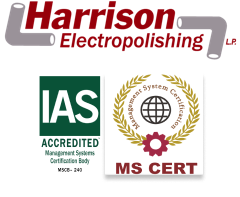- Home
- Passivation
- Passivation & Pickling
Passivation & Pickling
While Chemical Passivation is intended to remove free iron and surface contaminates, it is ineffective at removing existing oxidation, weld oxides, scale and heavy contaminates. Passivation and Pickling are often used together on equipment to remove all contaminates and oxidation, improving the corrosion resistance, and extending the life and overall value of your components.
Metal Pickling
Pickling is intended to dissolve any existing oxidation, scale and weld oxides, and is capable of etching the base material. It utilizes more aggressive acids than those used in passivation. Metal pickling is most often used to remove the real world effects of handling, forming and fabrication. It is used to remove oxides on the surface of metal, caused by high temperature and corrosive environments. Harrison is capable of performing pickling of large components by submersion, circulation or spray techniques.
Passivation
Passivation is the treatment of a stainless steel with a mild oxidant with intent to remove free iron and other foreign matter, for the purpose of improving corrosion resistance by enhancing the formation and structure of the material’s naturally occurring, corrosion-resistant passive film. Passivation prepares the alloy to perform to its engineered capabilities, in a corrosive environment. The chemicals used in the passivation process are not aggressive enough to dissolve surface oxides, thus, pickling may be used prior to, or in lieu of, passivation.
Harrison Electropolishing has provided chemical passivation and pickling services since 1980. We have the capacity to pickle and passivate components of all sizes and can perform pickling treatments in compliance with ASTM and AMS specifications or to your specific company or industry standard.


